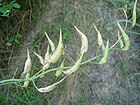Note: This is a project under development. The articles on this wiki are just being initiated and broadly incomplete. You can Help creating new pages.
Difference between revisions of "Raphanus sativus - Mulaka"
(→List of Ayurvedic medicine in which the herb is used) |
|||
| Line 45: | Line 45: | ||
==List of Ayurvedic medicine in which the herb is used== | ==List of Ayurvedic medicine in which the herb is used== | ||
| − | + | [[Moolaka kshara]], [[Moolakadi kashaya]], [[Shushka mulaka taila]], [[Sarshapadi pralepa]] | |
| − | |||
| − | |||
| − | |||
| − | |||
==Where to get the saplings== | ==Where to get the saplings== | ||
Revision as of 16:29, 2 January 2024
Mulaka is a plant in the mustard family cultivated throughtout the world for its pungent edible roots.
Contents
- 1 Uses
- 2 Parts Used
- 3 Chemical Composition
- 4 Common names
- 5 Properties
- 6 Habit
- 7 Identification
- 8 List of Ayurvedic medicine in which the herb is used
- 9 Where to get the saplings
- 10 Mode of Propagation
- 11 How to plant/cultivate
- 12 Commonly seen growing in areas
- 13 Photo Gallery
- 14 References
- 15 External Links
Uses
Hemmarhoids, Burning sensation, Eye disorders, Cough.[1]
Parts Used
Chemical Composition
Raphanus sativus consists of two terpenes (12–13), and two phenolic acids (14–15). All chemical structures were elucidated via 1H NMR and 13C NMR spectroscopic methods, and further supported by comparison with literature data. Compound 11 was isolated from the genus Raphanus for the first time. Notably, Compounds 7, 9, and 12–14 were reported in the Brassicaceae family for the first time. The chemotaxonomic significance of these compounds is discussed.
Common names
| Language | Common name |
|---|---|
| Kannada | Moolangi, |
| Hindi | Mooli |
| Malayalam | Kankapal, Mullangi |
| Tamil | Mullangi |
| Telugu | Mullangi |
| Marathi | NA |
| Gujarathi | NA |
| Punjabi | NA |
| Kashmiri | NA |
| Sanskrit | Mulaka, Mulakam, Muli, Mulika |
| English | Radish |
Properties
Reference: Dravya - Substance, Rasa - Taste, Guna - Qualities, Veerya - Potency, Vipaka - Post-digesion effect, Karma - Pharmacological activity, Prabhava - Therepeutics.
Dravya
Rasa
Tikta (Bitter), Katu (Pungent)
Guna
Laghu (Light)
Veerya
Sheeta (cold)
Vipaka
Katu (Pungent)
Karma
Pitta, Vata, Kapha
Prabhava
Habit
Identification
Leaf
| Kind | Shape | Feature |
|---|---|---|
| Lyrate | Alternate | Lower leaves lyrate-pinnatifid, ovate-oblong in general outline, long-stalked, 3-5-jugate, terminal lobes suborbicular, rounded at apex, crenate along margins. |
Flower
| Type | Size | Color and composition | Stamen | More information |
|---|---|---|---|---|
| Bisexual | Racemes | White/pink | Racemes many flowered, up to 40 cm long in fruit. pedicels 1-2 cm long in fruit. |
Fruit
| Type | Size | Mass | Appearance | Seeds | More information |
|---|---|---|---|---|---|
| Siliqua | 2-6 x 0.4-0.5 cm | Beak conical, seedless, 1-2 cm long; valves spongy, scarsely ribbed, often obscurely constricted between seeds | {{{5}}} | {{{6}}} |
Other features
List of Ayurvedic medicine in which the herb is used
Moolaka kshara, Moolakadi kashaya, Shushka mulaka taila, Sarshapadi pralepa
Where to get the saplings
Mode of Propagation
How to plant/cultivate
Seed - sow in situ in succession. Germination takes place within a few days of sowing the seed. If you want a constant supply of the roots then you need to sow seed every 2 - 3 weeks. [4]
Commonly seen growing in areas
Tropical area, Sub Tropical area
Photo Gallery
References
- ↑ Uses
- ↑ Vernacular names
- ↑ [Leaf info]
- ↑ Cultivation details
Cite error: <ref> tag with name "Ayurvedic preparations" defined in <references> is not used in prior text.
External Links
- Pages with reference errors
- Ayurvedic Herbs known to be helpful to treat Hemmarhoids
- Ayurvedic Herbs known to be helpful to treat Burning sensation
- Ayurvedic Herbs known to be helpful to treat Eye disorders
- Ayurvedic Herbs known to be helpful to treat Cough
- Herbs with Flowers used in medicine
- Herbs with Leaves used in medicine
- Herbs with Roots used in medicine
- Herbs with common name in Kannada
- Herbs with common name in Hindi
- Herbs with common name in Malayalam
- Herbs with common name in Tamil
- Herbs with common name in Telugu
- Herbs with common name in Sanskrit
- Herbs with common name in English
- Habit - Herb
- Index of Plants which can be propagated by Seeds
- Herbs that are commonly seen in the region of Tropical area
- Herbs that are commonly seen in the region of Sub Tropical area
- Herbs
- Ayurvedic herbs that don't have seed photos
- Brassicaceae





